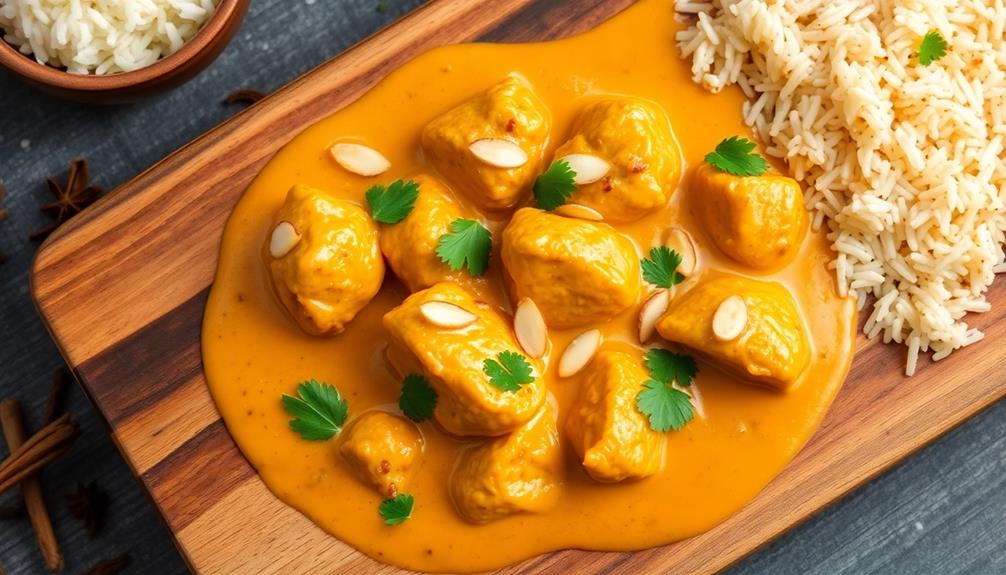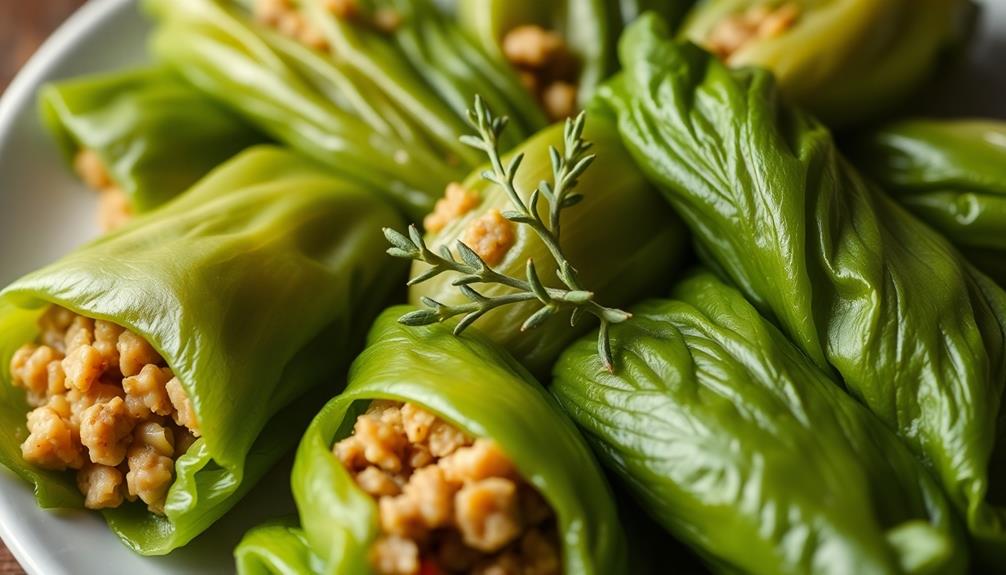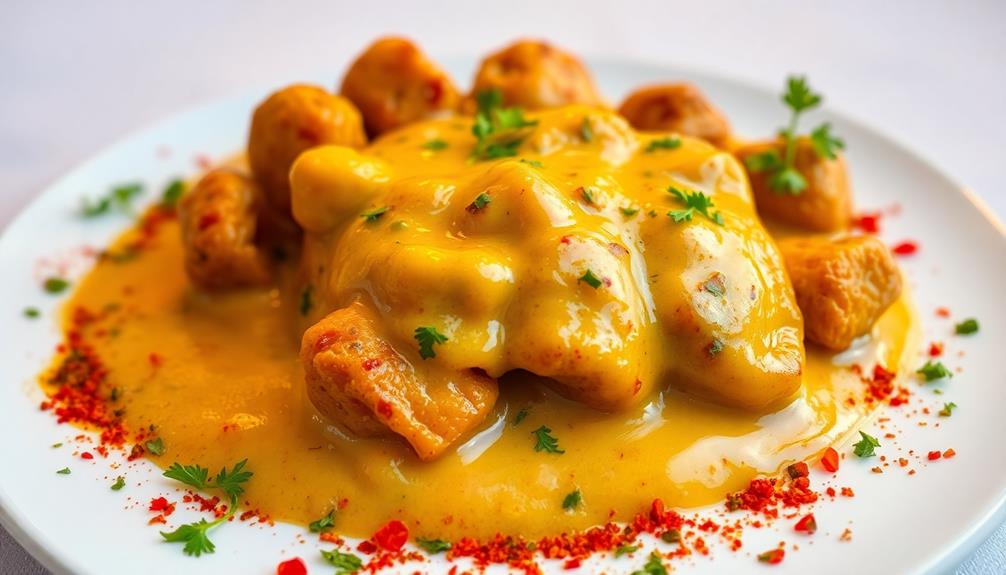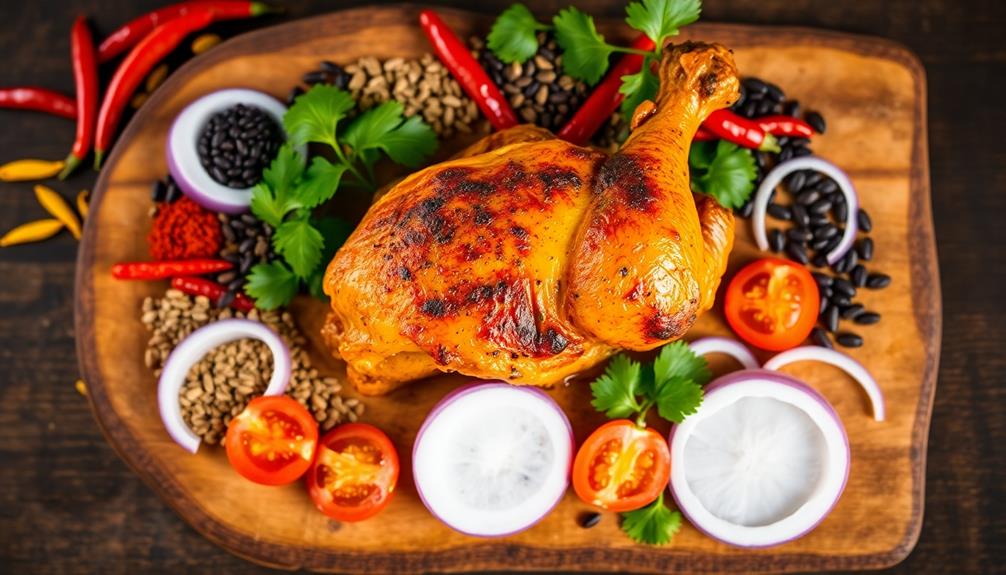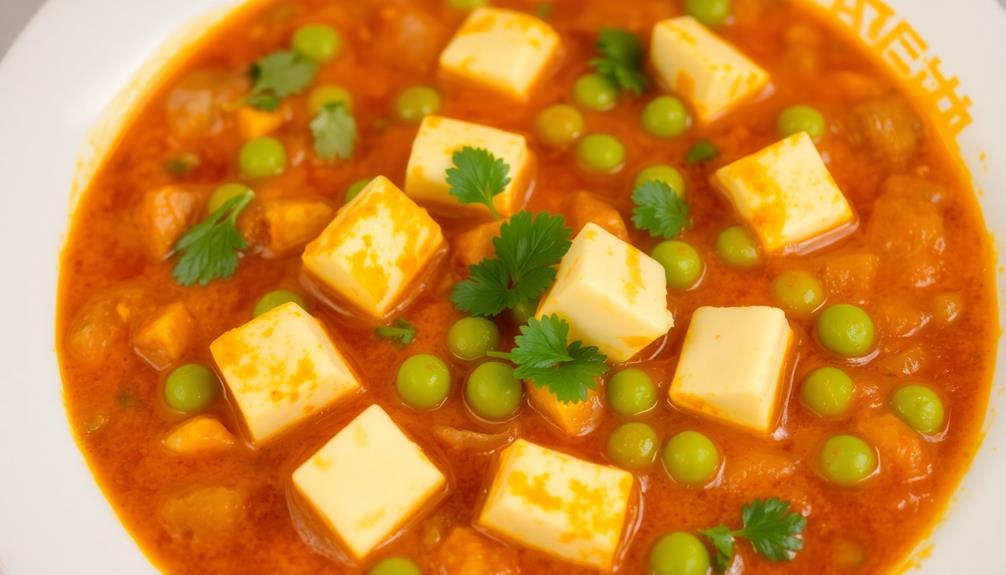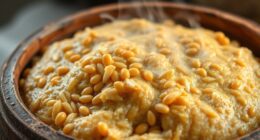Chicken korma is a beloved Indian dish that'll take your taste buds on an amazing journey! Its rich and creamy sauce is the star, made with aromatic spices like coriander, cumin, and turmeric. You'll sear the chicken to lock in the flavor, then simmer it all together until it's tender and infused with those mouthwatering spices. Top it off with fresh cilantro for a burst of brightness. Korma's comforting, satisfying flavors make it perfect for special occasions or an everyday meal. Try your hand at this beloved recipe, and you'll discover why it's a cherished classic in Indian cuisine.
Key Takeaways
- Chicken korma is a popular Indian dish that originated during the Mughal era, combining aromatic spices and tender chicken.
- The dish features a rich, creamy sauce made with yogurt, coconut milk, and a blend of spices like coriander, cumin, and turmeric.
- Chicken korma has evolved regionally, with variations across northern and southern India, making it a beloved staple in Indian cuisine.
- Preparation involves frying onions, searing chicken, and simmering the meat in the korma sauce until it's tender and flavorful.
- Chicken korma is commonly served with basmati rice or naan bread, and can be customized for different dietary preferences.
History
Chicken korma is a centuries-old dish that originated in the Indian subcontinent. This flavorful curry has a rich and creamy texture, with a mild blend of spices that tantalize the taste buds. Its roots can be traced back to the Mughal era, when the royal chefs of the Mughal Empire first combined the aromatic spices and tender chicken to create this delightful dish.
Over the years, chicken korma has evolved and spread throughout the Indian subcontinent, with each region adding its own unique twist. From the fragrant kormas of the north to the tangy versions of the south, the dish has become a beloved staple in Indian cuisine.
Today, it continues to be a popular choice for both special occasions and everyday meals, bringing families and friends together with its comforting flavors and inviting aroma.
Recipe
Chicken Korma is a beloved dish from the Indian subcontinent, featuring tender chicken in a creamy, aromatic sauce. The combination of spices, yogurt, and coconut milk creates a harmonious blend of flavors that's sure to delight your taste buds.
Originating from the Mughal era, Chicken Korma has become a staple in many Indian and Pakistani households. The dish's rich and mildly spiced nature makes it a crowd-pleaser, perfect for family gatherings or special occasions. Another popular variation of this dish is the delicious vegetable korma recipe, which replaces the chicken with a medley of fresh vegetables. This makes it a great option for vegetarians and adds a colorful and nutritious twist to the traditional dish. Whether you’re enjoying a classic chicken korma or a flavorful vegetable korma, this dish is sure to be a hit at any gathering.
- Chicken, cut into bite-sized pieces
- Onion, finely chopped
- Garlic cloves, minced
- Ginger, grated
- Yogurt
- Coconut milk
- Coriander powder
- Cumin powder
- Turmeric powder
- Chili powder (or cayenne pepper)
- Salt to taste
- Ghee or oil for cooking
- Chopped cilantro for garnish
In a large pan or pot, heat the ghee or oil over medium heat. Add the chopped onions and sauté until they become translucent.
Then, add the minced garlic and grated ginger, and continue to cook for 1-2 minutes until fragrant. Next, add the chicken pieces and sear them on all sides until they're lightly browned.
Pour in the yogurt and coconut milk, and then add the coriander powder, cumin powder, turmeric powder, and chili powder. Stir well to combine all the ingredients.
Reduce the heat to low, cover the pot, and let the Chicken Korma simmer for 20-25 minutes, or until the chicken is cooked through and the sauce has thickened. Adjust the seasoning with salt to taste.
To enhance the flavor further, you can add a handful of chopped cashews or almonds towards the end of the cooking process.
Serve the Chicken Korma hot, garnished with freshly chopped cilantro, and accompanied by basmati rice or naan bread for a truly authentic dining experience.
Cooking Steps
First, you'll need to fry the onions until they're nice and translucent.
Then, add the spices and sear the chicken to lock in all that flavor.
Next, stir in the yogurt and give it a good blend.
Finally, let it all simmer away until the chicken is tender and delicious.
Don't forget to garnish with fresh coriander for the perfect finishing touch!
Step 1. Fry Onions Until Translucent

Next, you'll want to fry the onions until they're translucent. Grab a large skillet and heat it over medium heat. Add a few tablespoons of oil – something neutral like vegetable or canola oil will work great.
Once the oil is hot, toss in the sliced onions. Stir them around frequently, making sure they cook evenly.
You'll know the onions are ready when they become soft and lose their bright, raw color, transforming into a pale, golden hue. This should take around 5-7 minutes. Be patient and let them cook slowly – rushing this step will result in onions that are still crunchy.
Once the onions are nice and translucent, remove the skillet from the heat. This sets the stage for the next steps in the Chicken Korma recipe. The softened onions will add fantastic flavor and texture to the dish. Nice work getting them cooked just right!
Step 2. Add Spices and Sear Chicken
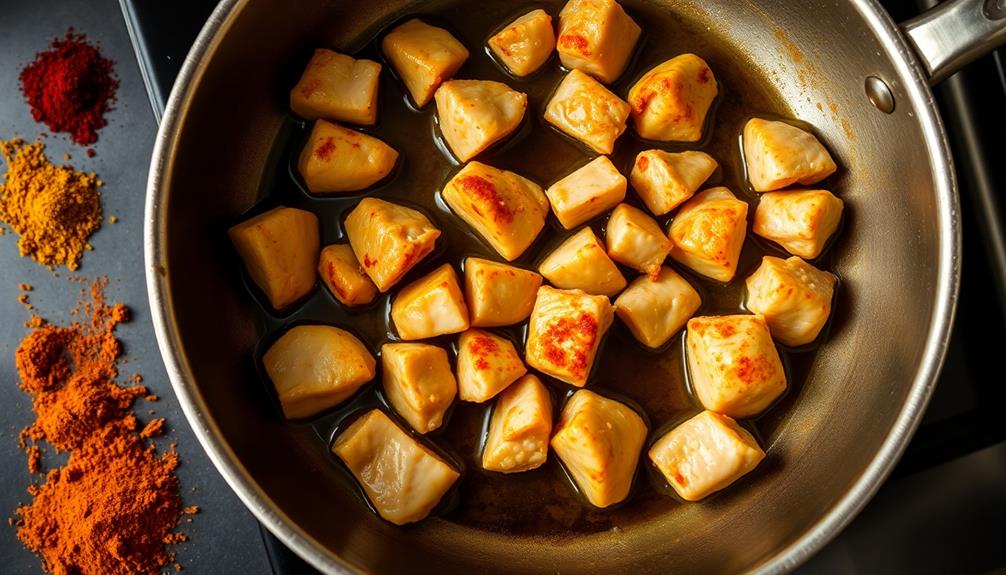
With the onions nicely softened, it's time to start adding the spices that will build the complex flavors of the Chicken Korma. First, sprinkle in the aromatic ground coriander, cumin, and garam masala. These warm, earthy spices will infuse the dish with their wonderful scents.
Don't forget the bright, zesty turmeric as well – it'll give the korma that vibrant, golden color. Adding spices not only enhances the flavor but can also contribute to digestive health benefits with ingredients like chia seeds being a great addition to your diet.
Stir the spices into the onions and let them toast for a minute or two. This'll help intensify their flavors.
Now it's time to add the star of the show: the chicken! Gently lower the chicken pieces into the fragrant spice mixture and sear them on both sides until they're nicely browned. This will lock in all that delicious flavor.
As the chicken cooks, be sure to keep stirring everything together so the spices coat the meat evenly. Soon, your kitchen will be filled with the mouthwatering aroma of authentic Chicken Korma. Get ready for a truly sensational dish!
Step 3. Add Yogurt and Blend
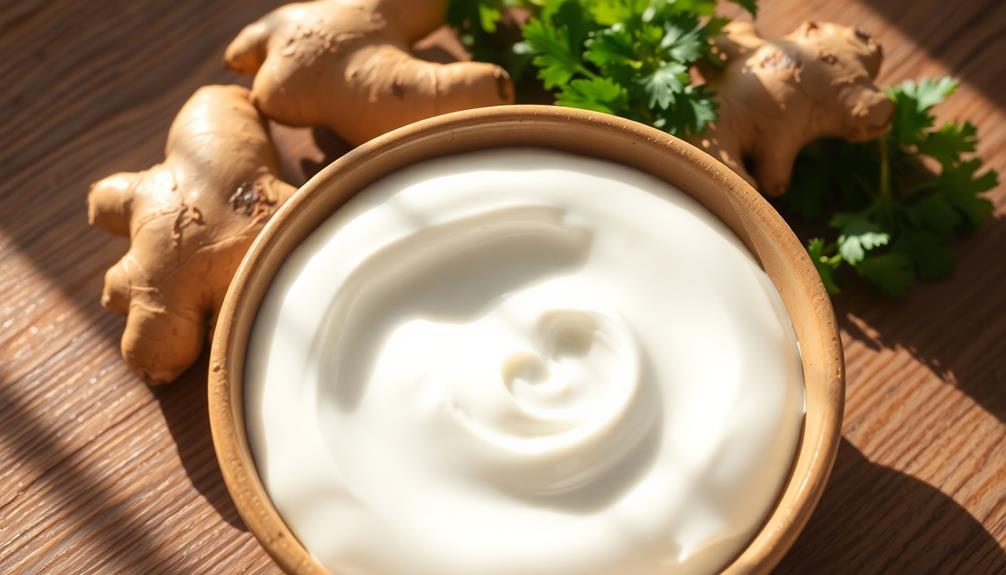
With the chicken seared to perfection, it's time to introduce the creamy, tangy component that will tie all the flavors together – yogurt. Grab a bowl and scoop in a generous amount of plain yogurt. You're going to want about 1 cup, give or take. Don't worry if it's not exact – this recipe is pretty forgiving.
Now, grab your blender or food processor. Carefully pour the yogurt into the blender, then add the garlic, ginger, and spices you cooked earlier. Give it all a good blitz until it's nice and smooth. The yogurt will help create that signature korma sauce – it's what makes this dish so wonderfully creamy and indulgent.
With the sauce blended, pour it right back into the pan with the seared chicken. Stir everything together until the chicken is fully coated.
Let it all simmer for about 10 minutes so the flavors can meld. Soon, your kitchen will be filled with the most amazing aroma. Get ready, because the best part is about to come!
Step 4. Simmer Until Chicken Is Tender

Now that the korma sauce is blended and coating the chicken, it's time to let it all simmer. Grab your pot and turn the heat to medium-low. Gently place the chicken pieces into the sauce, making sure they're fully submerged.
Let the mixture simmer for about 20-25 minutes, or until the chicken is cooked through and tender. You'll know it's done when the meat easily falls off the bone.
As the chicken simmers, the flavors will meld together beautifully. The spices will infuse the meat, creating a rich, aromatic dish.
Give the pot a stir every few minutes to ensure even cooking. You can even partially cover the pot with a lid to help the chicken cook faster. Just be sure to keep an eye on it so the sauce doesn't reduce too much.
When the chicken is tender, you're ready to move on to the next step. Get excited – the final result is going to be absolutely delicious!
Step 5. Garnish With Fresh Coriander
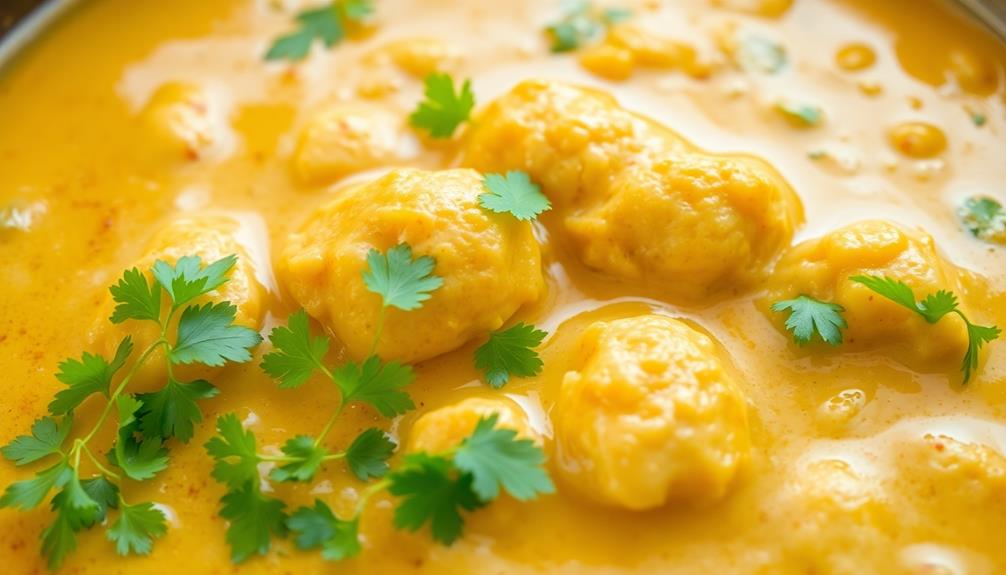
Once the chicken has simmered and become tender, you'll want to garnish the dish with fresh coriander to add a bright, herbaceous note.
Coriander, also known as cilantro, is a fragrant herb that pairs beautifully with the rich, creamy flavors of the korma. Simply take a handful of the fresh, green leaves and roughly chop them.
Sprinkle the chopped coriander over the top of the simmered chicken, ensuring each serving gets a nice garnish. The coriander will add a lovely pop of color and a refreshing, slightly citrusy flavor that balances out the dish.
This simple finishing touch takes just a moment but really elevates the entire meal. The coriander's vibrant green hue and delicate aroma will make your chicken korma look and smell absolutely irresistible.
Don't be afraid to be generous with the coriander – it's the perfect complement to the sumptuous, velvety sauce.
Final Thoughts
Chicken korma is a delightful and flavorful dish that's sure to satisfy your taste buds.
Now that you've mastered the art of preparing this mouthwatering meal, you can sit back, relax, and enjoy the fruits of your labor.
The combination of tender chicken, aromatic spices, and rich, creamy sauce is simply divine.
Whether you serve it with fragrant basmati rice, fluffy naan bread, or a fresh salad, this dish is sure to impress your family and friends.
Don't be afraid to get creative and experiment with different variations, such as adding your favorite vegetables or trying different protein options.
Remember, the beauty of cooking is in the journey, so have fun and don't be afraid to make it your own.
Dig in and savor every bite of this delectable chicken korma!
Frequently Asked Questions
What Is the Origin of the Name "Chicken Korma"?
You know, the name "chicken korma" has quite an interesting history!
It actually comes from the Urdu word "qorma," which refers to a dish of meat or vegetables cooked in a creamy, spiced sauce. So the "chicken" part just tells you the main ingredient, while "korma" explains the delicious cooking method.
Isn't that cool? The dish has its roots in South Asian cuisine, but it's become popular all over the world.
Now you know the tasty origins of this flavorful meal!
Can I Use Yogurt Instead of Cream in the Recipe?
Absolutely! You can definitely use yogurt instead of cream in your recipe.
Yogurt will give the dish a nice tangy flavor and a creamy texture. Just be sure to use plain, unsweetened yogurt – the kind you'd use for things like tzatziki.
The yogurt will work just as well as cream, and it's a great way to make your dish a little bit healthier.
Give it a try and see how you like the results!
How Spicy Is the Traditional Chicken Korma Dish?
Ah, the traditional chicken korma dish! Well, it's usually on the milder side when it comes to spiciness.
The creamy sauce is infused with warm spices like coriander, cumin, and cardamom, creating a delightfully fragrant and comforting flavor.
While some versions may include a touch of chili for a bit of heat, the overall experience is more about the rich, velvety texture and aromatic blend of spices.
Can I Substitute Chicken With Other Meats in This Recipe?
Sure, you can absolutely substitute the chicken in a traditional chicken korma recipe with other meats!
Beef, lamb, or even shrimp would all work great. Just keep in mind that the cooking times may need to be adjusted slightly depending on the type of meat you choose.
The flavors of the spices and creamy sauce will still shine through, no matter which protein you decide to use.
Have fun experimenting and finding your perfect korma combination!
How Long Does Chicken Korma Typically Take to Prepare?
Chicken Korma can take anywhere from 30 minutes to an hour to prepare, depending on your cooking skills and the recipe you're using.
The key is to take your time and follow the instructions carefully.
Don't be afraid to experiment with different spices and flavors to find the perfect balance that suits your taste buds.
With a little bit of practice, you'll be whipping up delicious Chicken Korma in no time!
